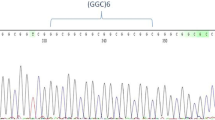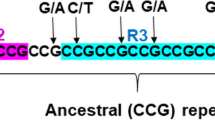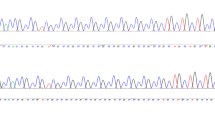Abstract
Across human protein-coding genes, the human neuron-specific genes, RIT2 and GPM6B, contain the two longest GA short tandem repeats (STRs) of 11 and 9-repeats, respectively, the length ranges of which are functional, and result in gene expression alteration. Here we sequenced the RIT2 and GPM6B STRs in 600 human subjects, consisting of late-onset neurocognitive disorder (n = 200), multiple sclerosis (n = 200), and controls (n = 200). Furthermore, we selected two large human databases, including the general-population-based gnomAD (https://gnomad.broadinstitute.org) and a mainly disease-phenotype-archiving database, TOPMed (https://www.nhlbiwgs.org), to compare allele frequencies in the general populations vs. the disease compartment. The RIT2 and GPM6B GA-repeats were monomorphic in the human subjects studied, at lengths of 11 and 9-repeats, respectively, and were predominantly human-specific in formula. Exception included a 9/11 genotype of the RIT2 GA-STR in an isolate case of female multiple sclerosis. Exceedingly rare alleles of the two GA repeats were significantly enriched in TOPMed vs. the gnomAD. We report prime instances of predominant monomorphism for specific lengths of STRs in human, and possible enrichment of rare divergent alleles in the disease phenotype compartment. While STRs are most attended because of their high polymorphic nature, STR monomorphism is an underappreciated feature, which may have a link with natural selection and disease.


Similar content being viewed by others
Data availability
Raw data are available upon request to the corresponding author.
Abbreviations
- AMTS:
-
Abbreviated Mental Test Score
- GPM6B:
-
Glycopreotein membrane 6B
- GnomAD:
-
Genome Aggregation Database
- MS:
-
Multiple sclerosis
- NCD:
-
Neurocognitive disorder
- RIT2:
-
Ras-like without CAAX 2
- STR:
-
Short tandem repeat
- TOPMed:
-
Trans-Omics for Precision Medicine
- TSS:
-
Transcription start site
- UTR:
-
Untranslated region
References
Afshar H, Adelirad F, Kowsari A, Kalhor N, Delbari A, Najafipour R et al (2020) Natural selection at the NHLH2 core promoter exceptionally long CA-repeat in human and disease-only genotypes in late-onset neurocognitive disorder. Gerontology 66(5):514–522
Afshar H, Khamse S, Alizadeh F, Delbari A, Najafipour R, Bozorgmehr A, Khazaei M, Adelirad F, Alizadeh A, Kowsari A, Ohadi M (2020) Evolving evidence on a link between the ZMYM3 exceptionally long GA-STR and human cognition. Sci Rep 10(1):19454. https://doi.org/10.1038/s41598-020-76461-z
Alharby E, Albalawi AM, Nasir A, Alhijji SA, Mahmood A, Ramzan K et al (2017) A homozygous potentially pathogenic variant in the PAXBP1 gene in a large family with global developmental delay and myopathic hypotonia. Clin Genet 92(6):579–586
Arabfard M, Kavousi K, Delbari A, Ohadi M (2018) Link between short tandem repeats and translation initiation site selection. Hum Genomics 12(1):1–11
Bang ML, Vainshtein A, Yang HJ, Eshed-Eisenbach Y, Devaux J, Werner HB et al (2018) Glial M6B stabilizes the axonal membrane at peripheral nodes of Ranvier. Glia 66(4):801–812
Bushehri A, Barez MRM, Mansouri SK, Biglarian A, Ohadi M (2016) Genome-wide identification of human-and primate-specific core promoter short tandem repeats. Gene 587(1):83–90
Emamalizadeh B, Movafagh A, Darvish H, Kazeminasab S, Andarva M, Namdar-Aligoodarzi P et al (2017) The human RIT2 core promoter short tandem repeat predominant allele is species-specific in length: a selective advantage for human evolution? Mol Genet Genomics 292(3):611–617
Essmann U, Perera L, Berkowitz ML, Darden T, Lee H, Pedersen LG (1995) A smooth particle mesh Eald method. J Chem Phys 103(19):8577–8593
Fliege J, Svaiter BF (2000) Steepest descent methods for multicriteria optimization. Math Methods Oper Res 51(3):479–494
Foroughan M, Wahlund LO, Jafari Z, Rahgozar M, Farahani IG, Rashedi V (2017) Validity and reliability of a bbreviated M ental T Est S core (AMTS) among older I ranian. Psychogeriatrics 17(6):460–465
Fotsing SF, Margoliash J, Wang C, Saini S, Yanicky R, Shleizer-Burko S et al (2019) The impact of short tandem repeat variation on gene expression. Nat Genet 51(11):1652–1659
Herbert A (2020) Simple repeats as building blocks for genetic computers. Trends Genet. https://doi.org/10.1016/j.tig.2020.06.012
Hess B, Bekker H, Berendsen HJC, Fraaije JGEM (1997) LINCS: a linear constraint solver for molecular simulations. J Comput Chem 18(12):1463–1472
Hodkinson H (1972) Evaluation of a mental test score for assessment of mental impairment in the elderly. Age Ageing 1(4):233–238
Humphrey W, Dalke A, Schulten K (1996) VMD: visual molecular dynamics. J Mol Graph 14(1):33–38
Jafarian Z, Khamse S, Afshar H, Khorshid HRK, Delbari A, Ohadi M (2021) Natural selection at the RASGEF1C (GGC) repeat in human and divergent genotypes in late-onset neurocognitive disorder. Sci Rep 11(1):19235. https://doi.org/10.1038/s41598-021-98725-y
Jakubosky D, D’Antonio M, Bonder MJ, Smail C, Donovan MKR, Greenwald WWY et al (2020) Properties of structural variants and short tandem repeats associated with gene expression and complex traits. Nat Commun 11(1):1–15
Jo S, Kim T, Iyer VG, Im W (2008) CHARMM-GUI: a web-based graphical user interface for CHARMM. J Comput Chem 29(11):1859–1865
Khademi E, Alehabib E, Shandiz EE, Ahmadifard A, Andarva M, Jamshidi J et al (2017) Support for “disease-only” genotypes and excess of homozygosity at the CYTH4 primate-specific GTTT-repeat in schizophrenia. Genet Test Mol Biomark 21(8):485–490
Khamse S, Jafarian Z, Bozorgmehr A, Tavakoli M, Afshar H, Keshavarz M, Moayedi R, Ohadi M (2021) Novel implications of a strictly monomorphic (GCC) repeat in the human PRKACB gene. Sci Rep 11(1):20629. https://doi.org/10.1038/s41598-021-99932-3
Koch L (2020) Exploring human genomic diversity with gnomAD. Nat Rev Genet 21:448. https://doi.org/10.1038/s41576-020-0255-728
Lagenaur C, Kunemund V, Fischer G, Fushiki S, Schachner M (1992) Monoclonal M6 antibody interferes with neurite extension of cultured neurons. J Neurobiol 23(1):71–88
Makov G, Payne MC (1995) Periodic boundary conditions in ab initio calculations. Phys Rev B 51(7):4014
Mohammadparast S, Bayat H, Biglarian A, Ohadi M (2014) Exceptional expansion and conservation of a CT-repeat complex in the core promoter of PAXBP1 in primates. Am J Primatol 76(8):747–756
Namdar-Aligoodarzi P, Mohammadparast S, Zaker-Kandjani B, Kakroodi ST, Vesiehsari MJ, Ohadi M (2015) Exceptionally long 5′ UTR short tandem repeats specifically linked to primates. Gene 569(1):88–94
Nikkhah M, Rezazadeh M, Khorram Khorshid HR, Biglarian A, Ohadi M (2016) An exceptionally long CA-repeat in the core promoter of SCGB2B2 links with the evolution of apes and Old World monkeys. Gene 576(1 Pt 1):109–114. https://doi.org/10.1016/j.gene.2015.09.070 (Epub 2015 Oct 3 PMID: 26437309)
Ohadi M, Mohammadparast S, Darvish H (2012) Evolutionary trend of exceptionally long human core promoter short tandem repeats. Gene 507(1):61–67
Ohadi M, Valipour E, Ghadimi-Haddadan S, Namdar-Aligoodarzi P, Bagheri A, Kowsari A et al (2015) Core promoter short tandem repeats as evolutionary switch codes for primate speciation. Am J Primatol 77(1):34–43
Ranathunge C, Wheeler GL, Chimahusky ME, Perkins AD, Pramod S, Welch ME (2020) Transcribed microsatellite allele lengths are often correlated with gene expression in natural sunflower populations. Mol Ecol 29(9):1704–1716
Ranathunge C et al (2021) Microsatellites as agents of adaptive change: an RNA-seq-based comparative study of transcriptomes from five Helianthus Species. Symmetry 13(6):933. https://doi.org/10.3390/sym13060933
Schuster SC, Miller W et al (2010) Complete Khoisan and Bantu genomes from southern Africa. Nature 463(7283):943–947. https://doi.org/10.1038/nature08795
Shimada MK, Sanbonmatsu R, Yamaguchi-Kabata Y et al (2016) Selection pressure on human STR loci and its relevance in repeat expansion disease. Mol Genet Genomics 291:1851–1869. https://doi.org/10.1007/s00438-016-1219-712
Taliun D, Harris DN, Kessler MD et al (2021) Sequencing of 53,831 diverse genomes from the NHLBI TOPMed Program. Nature 590:290–299. https://doi.org/10.1038/s41586-021-03205-y27
Valipour E, Kowsari A, Bayat H, Banan M, Kazeminasab S, Mohammadparast S et al (2013) Polymorphic core promoter GA-repeats alter gene expression of the early embryonic developmental genes. Gene 531(2):175–179
Van Der Spoel D, Lindahl E, Hess B, Groenhof G, Mark AE, Berendsen HJC (2005) GROMACS: fast, flexible, and free. J Comput Chem 26(16):1701–1718
Vanommeslaeghe K, Hatcher E, Acharya C, Kundu S, Zhong S, Shim J et al (2010) CHARMM general force field: A force field for drug-like molecules compatible with the CHARMM all-atom additive biological force fields. J Comput Chem 31(4):671–690
Watts PC, Kallio ER, Koskela E, Lonn E, Mappes T, Mokkonen M (1869) Stabilizing selection on microsatellite allele length at arginine vasopressin 1a receptor and oxytocin receptor loci. Proc R Soc B Biol Sci 2017(284):20171896
Werner HB, Krämer-Albers EM, Strenzke N, Saher G, Tenzer S, Ohno-Iwashita Y et al (2013) A critical role for the cholesterol-associated proteolipids PLP and M6B in myelination of the central nervous system. Glia 61(4):567–586
Yan M, Li J (2020) Combined application of CRISPR-Cas and stem cells for clinical and basic research. Cell Regen 9(1):1–3
Funding
This research was funded by the University of Social Welfare and Rehabilitation Sciences, Tehran, Iran.
Author information
Authors and Affiliations
Contributions
SK performed the molecular experiments. MA and MS contributed to data collection. EB performed the molecular simulation studies. HA collected the human samples and their information, and contributed to data collection. ZJ and MKh contributed to data collection. MO conceived and supervised the project, and wrote the manuscript.
Corresponding author
Ethics declarations
Conflict of interest
The authors declare no conflict of interest.
Additional information
Publisher's Note
Springer Nature remains neutral with regard to jurisdictional claims in published maps and institutional affiliations.
Rights and permissions
About this article
Cite this article
Khamse, S., Arabfard, M., Salesi, M. et al. Predominant monomorphism of the RIT2 and GPM6B exceptionally long GA blocks in human and enriched divergent alleles in the disease compartment. Genetica 150, 27–40 (2022). https://doi.org/10.1007/s10709-021-00143-5
Received:
Accepted:
Published:
Issue Date:
DOI: https://doi.org/10.1007/s10709-021-00143-5




